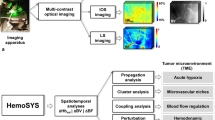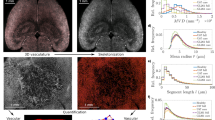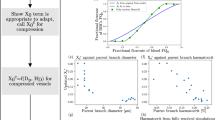Abstract
Not all tumor vessels are equal. Tumor-associated vasculature includes immature vessels, regressing vessels, transport vessels undergoing arteriogenesis and peritumor vessels influenced by tumor growth factors. Current techniques for analyzing tumor blood flow do not discriminate between vessel subtypes and only measure average changes from a population of dissimilar vessels. We developed methodologies for simultaneously quantifying blood flow (velocity, flux, hematocrit and shear rate) in extended networks at single-capillary resolution in vivo. Our approach relies on deconvolution of signals produced by labeled red blood cells as they move relative to the scanning laser of a confocal or multiphoton microscope and provides fully resolved three-dimensional flow profiles within vessel networks. Using this methodology, we show that blood velocity profiles are asymmetric near intussusceptive tissue structures in tumors in mice. Furthermore, we show that subpopulations of vessels, classified by functional parameters, exist in and around a tumor and in normal brain tissue.
This is a preview of subscription content, access via your institution
Access options
Subscribe to this journal
Receive 12 print issues and online access
$259.00 per year
only $21.58 per issue
Buy this article
- Purchase on Springer Link
- Instant access to full article PDF
Prices may be subject to local taxes which are calculated during checkout



Similar content being viewed by others
References
Fukumura, D., Yuan, F., Monsky, W.L., Chen, Y. & Jain, R.K. Effect of host microenvironment on the microcirculation of human colon adenocarcinoma. Am. J. Pathol. 151, 679–688 (1997).
Brizel, D.M. et al. A comparison of tumor and normal tissue microvascular hematocrits and red cell fluxes in a rat window chamber model. Int. J. Radiat. Oncol. Biol. Phys. 25, 269–276 (1993).
Endrich, B., Reinhold, H.S., Gross, J.F. & Intaglietta, M. Tissue perfusion inhomogeneity during early tumor growth in rats. J. Natl. Cancer Inst. 62, 387–395 (1979).
Nagy, J.A., Chang, S.H., Dvorak, A.M. & Dvorak, H.F. Why are tumour blood vessels abnormal and why is it important to know? Br. J. Cancer 100, 865–869 (2009).
Kamoun, W.S., Schmugge, S.J., Kraftchick, J.P., Clemens, M.G. & Shin, M.C. Liver microcirculation analysis by red blood cell motion modeling in intravital microscopy images. IEEE Trans. Biomed. Eng. 55, 162–170 (2008).
Rosenblum, W.I. & El-Sabban, F. Measurement of red cell velocity with a two-slit technique and cross-correlation: use of reflected light, and either regulated dc or unregulated ac power supplies. Microvasc. Res. 22, 225–227 (1981).
Kleinfeld, D., Mitra, P.P., Helmchen, F. & Denk, W. Fluctuations and stimulus-induced changes in blood flow observed in individual capillaries in layers 2 through 4 of rat neocortex. Proc. Natl. Acad. Sci. USA 95, 15741–15746 (1998).
Brown, E.B. et al. In vivo measurement of gene expression, angiogenesis and physiological function in tumors using multiphoton laser scanning microscopy. Nat. Med. 7, 864–868 (2001).
Drew, P.J., Blinder, P., Cauwenberghs, G., Shih, A.Y. & Kleinfeld, D. Rapid determination of particle velocity from space-time images using the Radon transform. J. Comput. Neurosci. published online, doi:10.1007/s10827-009-0159-1 (21 May 2009).
Lindsey, E.S., Donaldson, G.W. & Woodruff, M.F. Erythrocyte survival in normal mice and in mice with autoimmune haemolytic anaemia. Clin. Exp. Immunol. 1, 85–98 (1966).
Patan, S. et al. Vascular morphogenesis and remodeling in a human tumor xenograft: blood vessel formation and growth after ovariectomy and tumor implantation. Circ. Res. 89, 732–739 (2001).
Jain, R.K., Tong, R.T. & Munn, L.L. Effect of vascular normalization by antiangiogenic therapy on interstitial hypertension, peritumor edema, and lymphatic metastasis: insights from a mathematical model. Cancer Res. 67, 2729–2735 (2007).
Frangos, J.A., McIntire, L.V. & Eskin, S.G. Shear stress induced stimulation of mammalian cell metabolism. Biotechnol. Bioeng. 32, 1053–1060 (1988).
Jain, R.K., Munn, L.L. & Fukumura, D. Dissecting tumour pathophysiology using intravital microscopy. Nat. Rev. Cancer 2, 266–276 (2002).
Winkler, F. et al. Kinetics of vascular normalization by VEGFR2 blockade governs brain tumor response to radiation: role of oxygenation, angiopoietin-1, and matrix metalloproteinases. Cancer Cell 6, 553–563 (2004).
Tyrrell, J.A. et al. Robust 3-D modeling of vasculature imagery using superellipsoids. IEEE Trans. Med. Imaging 26, 223–237 (2007).
Acknowledgements
We thank T. Padera for editorial comments and S. Roberge for technical assistance. This work was supported in part by US National Institutes of Health grants R01HL064240 (L.L.M.), R01CA149285 (L.L.M.) and P01CA80124 (R.K.J.) and by a postdoctoral fellowship from the Susan G. Komen Foundation (W.S.K.).
Author information
Authors and Affiliations
Contributions
W.S.K. conceived and designed the experiment, validated and implemented the technique, collected data and wrote the manuscript. S.-S.C., D.A.L. and M.A.G. implemented the technique and collected data. J.A.T. conceived and designed the experiment and validated the technique. M.M. validated the technique. D.F. conceived and designed the experiment and provided administrative support. R.K.J. provided administrative and financial support and edited the manuscript. L.L.M. conceived and designed the experiment, provided administrative and financial support and wrote the manuscript.
Corresponding author
Ethics declarations
Competing interests
R.K.J. has advisory roles at AstraZeneca, Dyax, Enlight, SynDevRx, Millennium (1 time), Genzyme (1 time), Morphosys (1 time), Astellas (1 time) and Regeneron (1 time), and received honoraria for giving a lecture at Pfizer and Genzyme.
Supplementary information
Supplementary Text and Figures
Supplementary Figures 1–5 (PDF 2438 kb)
Rights and permissions
About this article
Cite this article
Kamoun, W., Chae, SS., Lacorre, D. et al. Simultaneous measurement of RBC velocity, flux, hematocrit and shear rate in vascular networks. Nat Methods 7, 655–660 (2010). https://doi.org/10.1038/nmeth.1475
Received:
Accepted:
Published:
Issue Date:
DOI: https://doi.org/10.1038/nmeth.1475
This article is cited by
-
Surmounting photon limits and motion artifacts for biological dynamics imaging via dual-perspective self-supervised learning
PhotoniX (2024)
-
Deep optoacoustic localization microangiography of ischemic stroke in mice
Nature Communications (2023)
-
Dynamic 3D imaging of cerebral blood flow in awake mice using self-supervised-learning-enhanced optical coherence Doppler tomography
Communications Biology (2023)
-
Macro-scale models for fluid flow in tumour tissues: impact of microstructure properties
Journal of Mathematical Biology (2022)
-
Imaging and optogenetic modulation of vascular mural cells in the live brain
Nature Protocols (2021)



